
6-18 #WorkTogether : Samsung is to release a next-gen flagship SoC feat its own GPU in 2026; Elon Musk believes smartphone will be replaced by the Neuralink neural interface; Tata Group is allegedly to acquire a majority stake in the Indian unit of vivo; etc.

The National Institute of Advanced Industrial Science and Technology (AIST) in Japan and IBM aim to develop a quantum computer with 10,000 quantum bits (qubits), which is 75 times the capacity of current quantum computers. In quantum computing, qubits are the basic unit of information—similar to binary bits in traditional computing—and are a rough measure of performance. The most advanced quantum computers today possess 133 qubits. The quantum computer being developed is expected to be operational by 2029. With over 10,000 qubits, it is anticipated to perform high-level computations without errors. (CN Beta, C114, Ariat Tech)
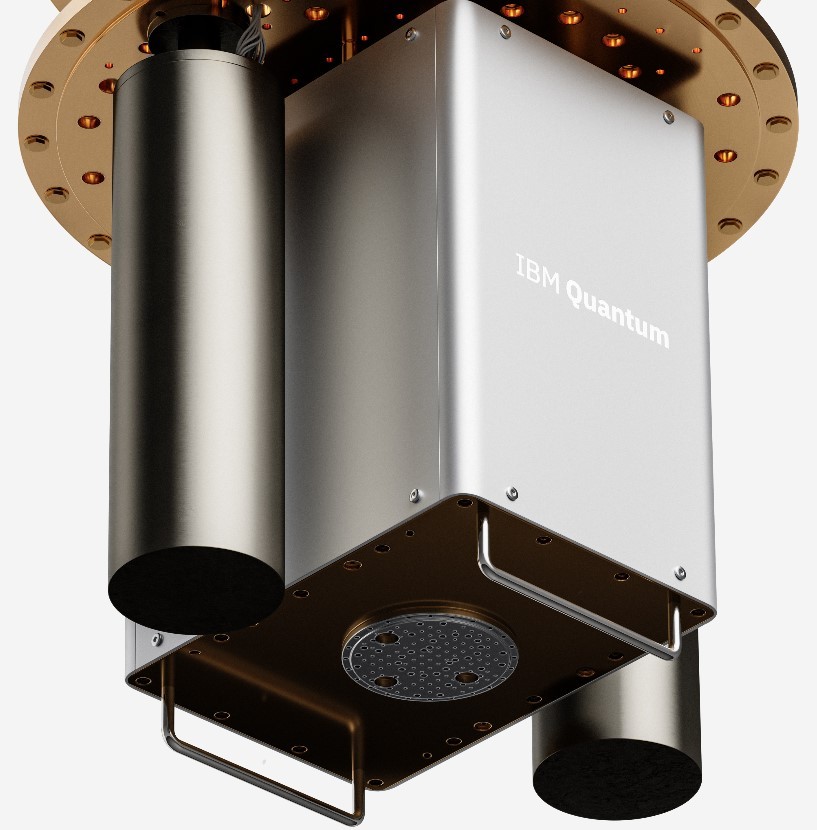
ASML has announced plans for a new lithography tool that will extend design limits for the highest transistor-density chips. The company’s former president, Martin van den Brink, surprised experts with the announcement of the new “Hyper-NA” EUV technology that is still in the early stages of development, according to global R&D organization imec, which has worked closely with ASML. In parallel, the company is driving the productivity on all of their systems to 400 to 500 wafers per hour. High-NA takes numerical aperture (NA) to 0.55 NA from the 0.33 NA of earlier EUV tools. About 3 years ago, the company said High-NA would help chipmakers reach process nodes well beyond 2nm for at least 10 years. Now, ASML has said that around 2030, the company will offer Hyper-NA, reaching 0.75 NA. (CN Beta, EE Times, Extreme Tech)
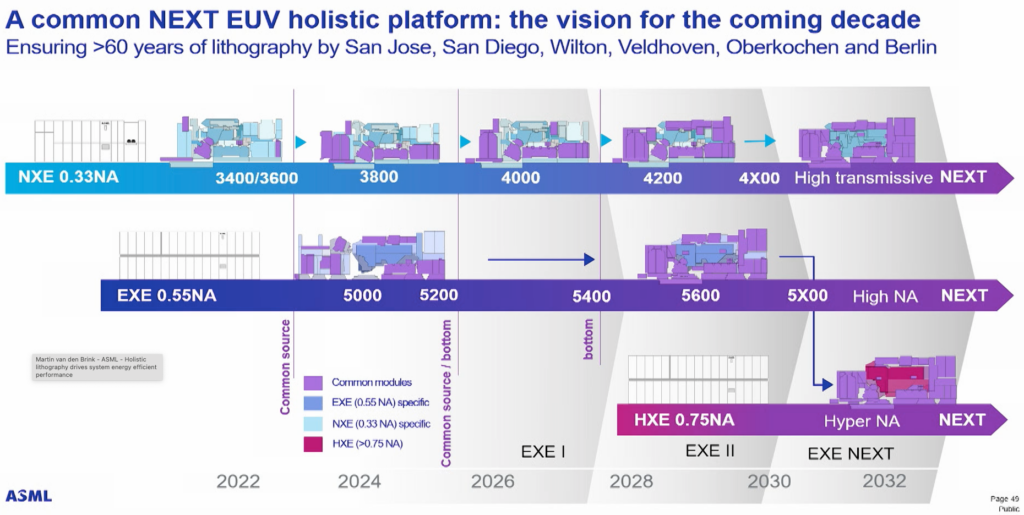
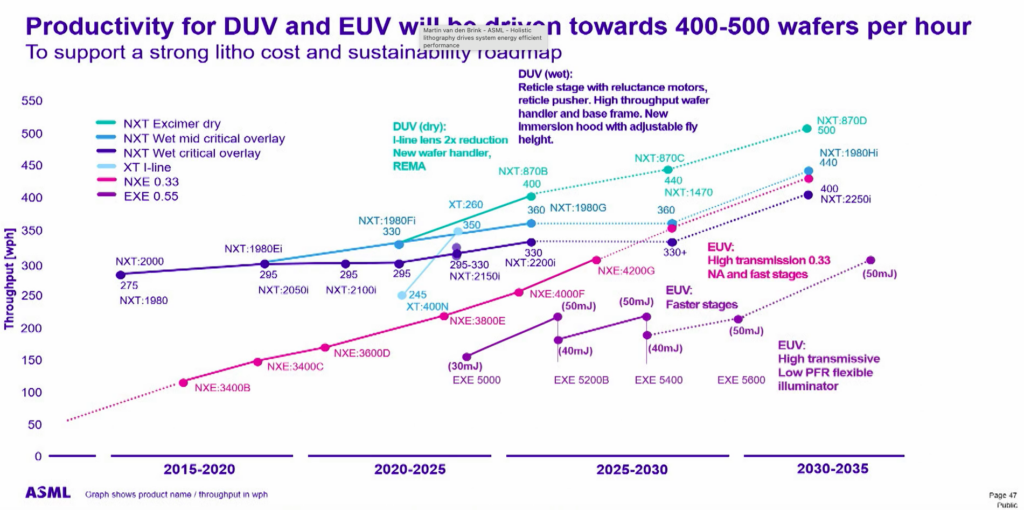
Samsung has been using Xclips GPUs (built in collaboration with AMD) in its flagship Exynos chips. The GPUs equip AMD RDNA graphics IP and were projected to offer reasonably better ray tracing performance. However, Samsung is rumored aiming for the release of a next-gen flagship SoC feat its own GPU in 2026, implying that Samsung may discontinue the partnership with AMD after 2025. Samsung reportedly aims to strengthen the company’s “GPU-related business competitiveness or to expand its internal information technology (IT) infrastructure”. The company is also investing in AI chips and advanced packaging methods. Given Samsung’s self-developed GPU manages to compete with the Adreno or Mali GPUs, it will offer the company more control over its products and will also likely save some costs. (Gizmo China, Naver)
Synopsys has announced that its design flow tools and intellectual property (IP) are ready for Samsung Foundry’s 2nm fabrication process. Samsung has recently announced that it will be ready for the mass production of 2nm semiconductor chips in 2025 and that this process will be further improved in 2027. Synopsys’ AI-driven analog and digital design tools have received certification for that process node with multiple chip tape-outs. Synopsys.ai is a full-stack Electronic Design Automation (EDA) suite that improves analog design migration, PPA, and productivity for Samsung Foundry’s 2nm Gate All Around (GAA) process node. Synopsys’ AI-driven design technology co-optimization (DTCO) solution has optimized Samsung’s 2 nm process, improving area, performance, and power efficiency.(CN Beta, Investing, SamMobile)
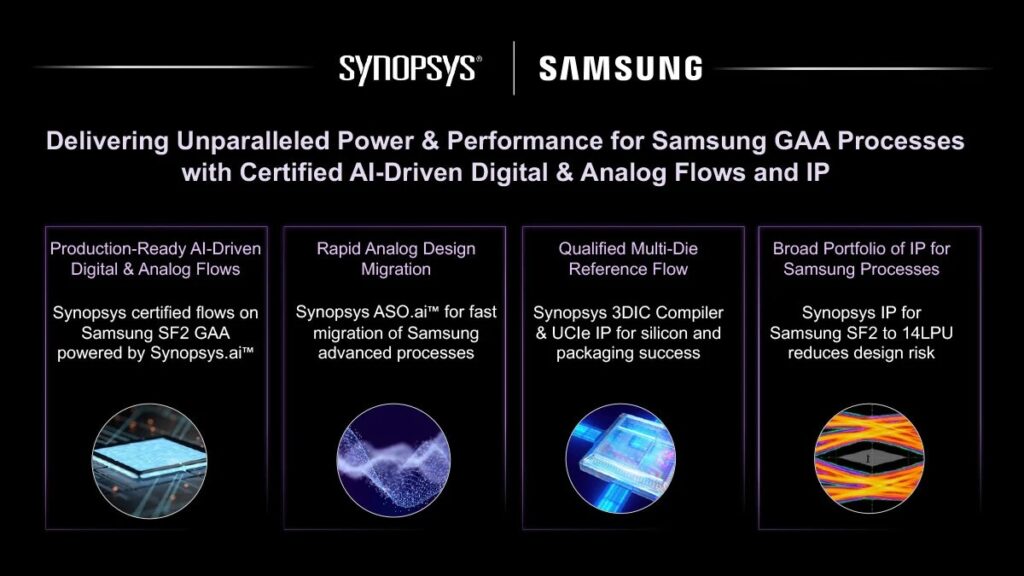
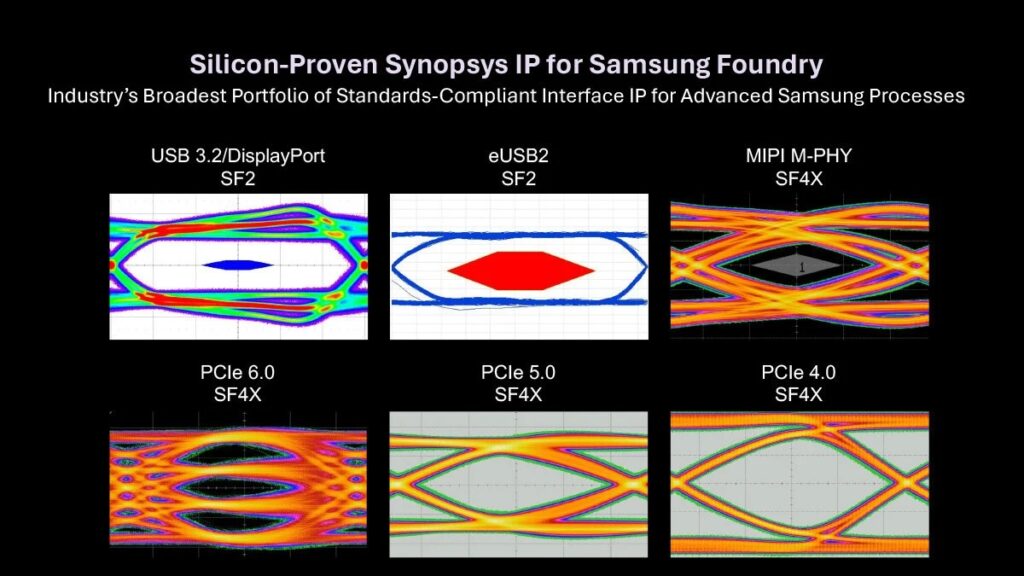

TFT backplane drivers mainly include LTPS, oxide and LTPO. LTPO is a combination of LTPS and oxide, and is the first choice for mid- to high-end mobile phones. OLED TFT backplane drivers mainly include Switching TFT (S-TFT) and Driving TFT (D-TFT). S-TFT is mainly responsible for controlling the OLED switch, and D-TFT is mainly responsible for adjusting the luminous brightness. In the past, only LTPS or oxide was used alone as the material for making S-TFT and D-TFT in the display backplane, but both had some limitations. LTPO combines the two, using oxide transistors as S-TFT and LTPS transistors as D-TFT, which can eliminate the potential flicker problem of using LTPS transistors, and can also make up for the brightness and efficiency problems caused by oxide transistor driving. The introduction of LTPO technology makes it possible to combine high refresh rate and low power consumption, and it has become the first choice for mid- to high-end mobile phones. (Guolian Securities report)
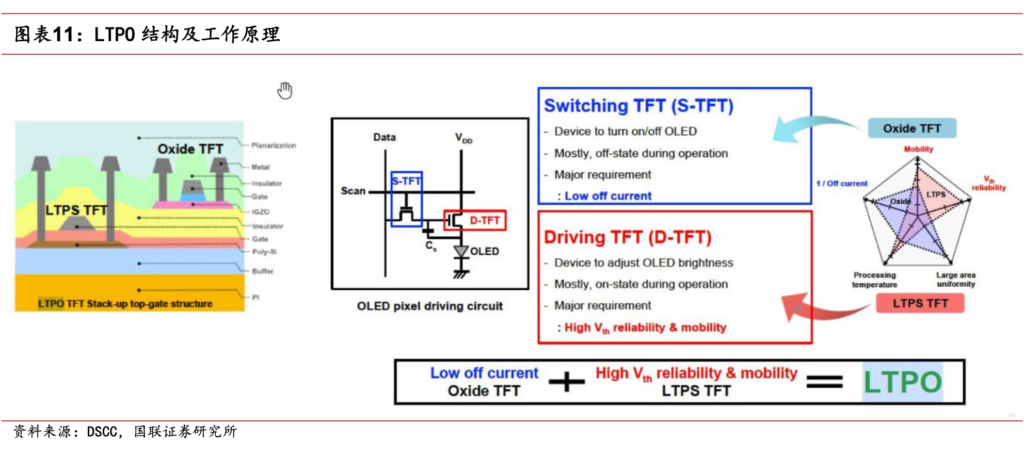
In terms of AMOLED process equipment, the key equipment in the array engineering section mainly includes cleaning machines, ion implanters, coating machines (plasma enhanced chemical vapor deposition equipment, sputtering machines), coating machines, exposure machines, developers and etching machines, etc.; the key equipment in the organic evaporation engineering section mainly includes evaporation equipment and various packaging equipment, etc.; the key equipment in the module engineering section mainly includes laser stripping equipment, cutting equipment, laminating equipment, bonding equipment and testing equipment, etc. The array engineering section and the organic evaporation engineering section involve many complex processes, and the main key equipment is produced and provided by companies in countries and regions such as Japan, South Korea and Taiwan, China; the process complexity of the module testing engineering section is relatively low, and domestic manufacturers have achieved domestic substitution. (Guolian Securities report)
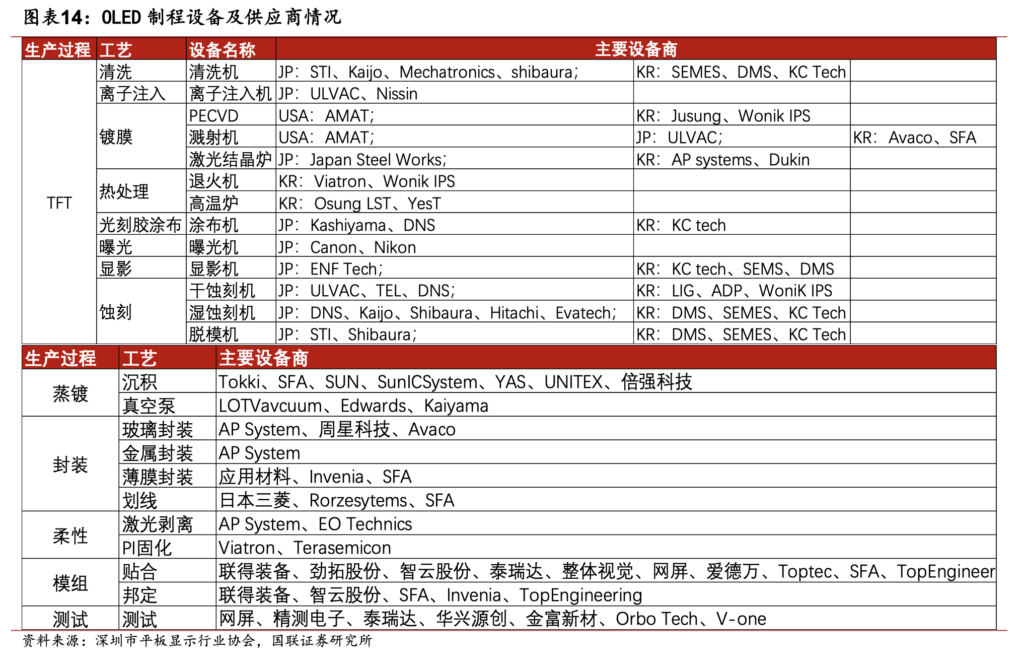
Foreign OLED organic material research and industrialization started early and have a good foundation. Large foreign-funded enterprises such as UDC, DuPont, and Merck have advantages in technology accumulation, financial strength, and industrial scale. Korean material enterprises such as Deshan Group and LG Chem are supported by local panel manufacturers Samsung and LG Display, and entered the OLED supply chain system earlier, enjoying first-mover advantages in the industry. From the perspective of the Chinese market, with the rapid development of the OLED panel industry and the rapid expansion of domestic production capacity, the focus of the global OLED panel industry will gradually shift to China, providing a broad market for domestic substitution of materials. (Guolian Securities report)
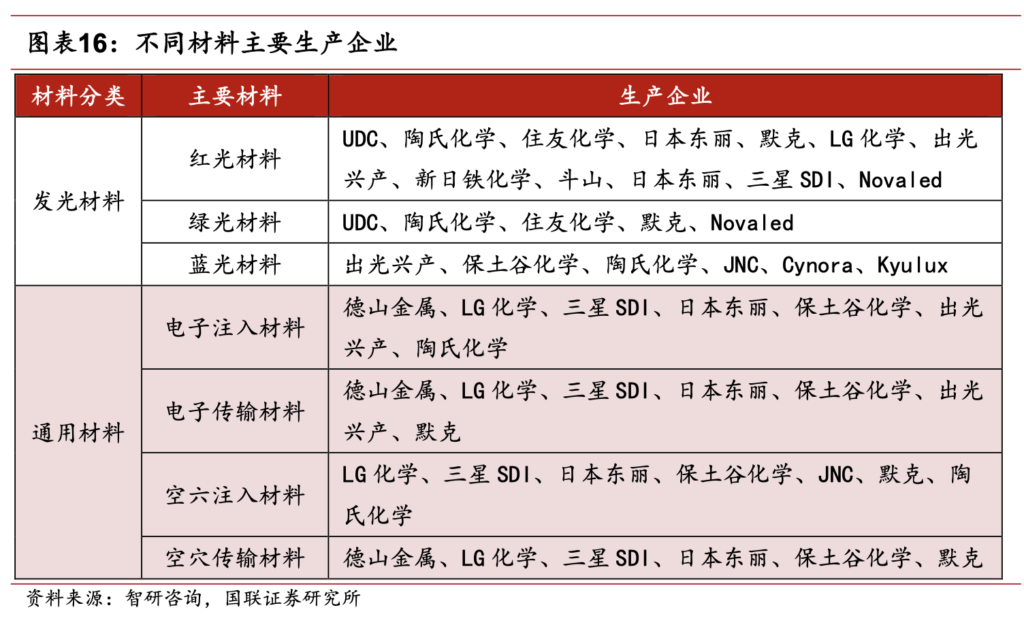
Huawei has been rumored to be working on such a tri-fold smartphone. However, it has likely run into development issues stemming from the advanced form factor, with problems such as software and possibly a lack of an effective cooling solution causing a delay. Huawei’s HarmonyOS relies on the Android Open Source Project platform and runs its own set of applications. The software adaption has yet to be ‘perfected,’ suggesting that the triple-screen solution might not play well with the operating system. Additionally, each of Huawei’s tri-fold displays would likely sport an extreme level of thinness, as making each panel even slightly thicker would increase the total bulk of the device when it is completely folded. Unfortunately, the chipset needs to be found in one of the three panels, and the sheer thinness probably means that there is inadequate cooling for the SoC. (GizChina, Twitter, WCCFTech)
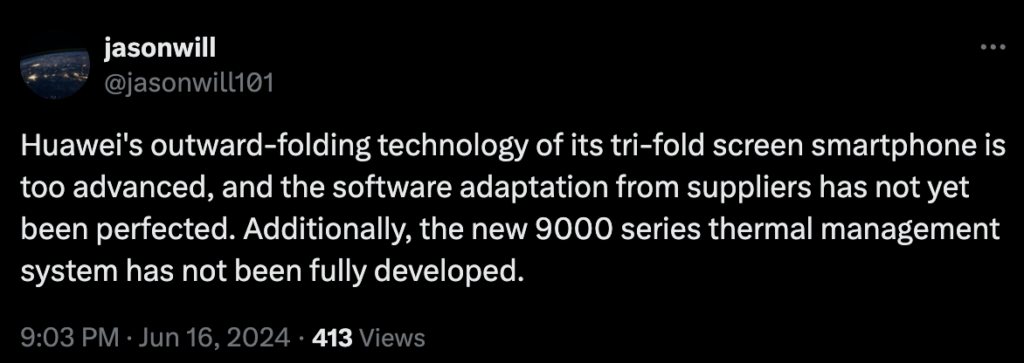

As a leader in big-size and big-pixel products, Sony believes that the big-size trend of high-end mobile phone CIS is still continuing. In the future, it will not only be limited to big-size main cameras, but the sensor size of secondary cameras will also continue to increase. In the forecast chart shown by Sony, if the average chip area of high-end mobile phone CIS is 100% by fiscal year 2019, the main camera CIS size will exceed 200% by fiscal year 2026, while the secondary camera will be close to 140%, and will increase to about 160% by fiscal year 2030. Founder Securities believes that the continuation of the big-size trend has also injected growth momentum into the mobile phone CIS market. (Founder Securities report)
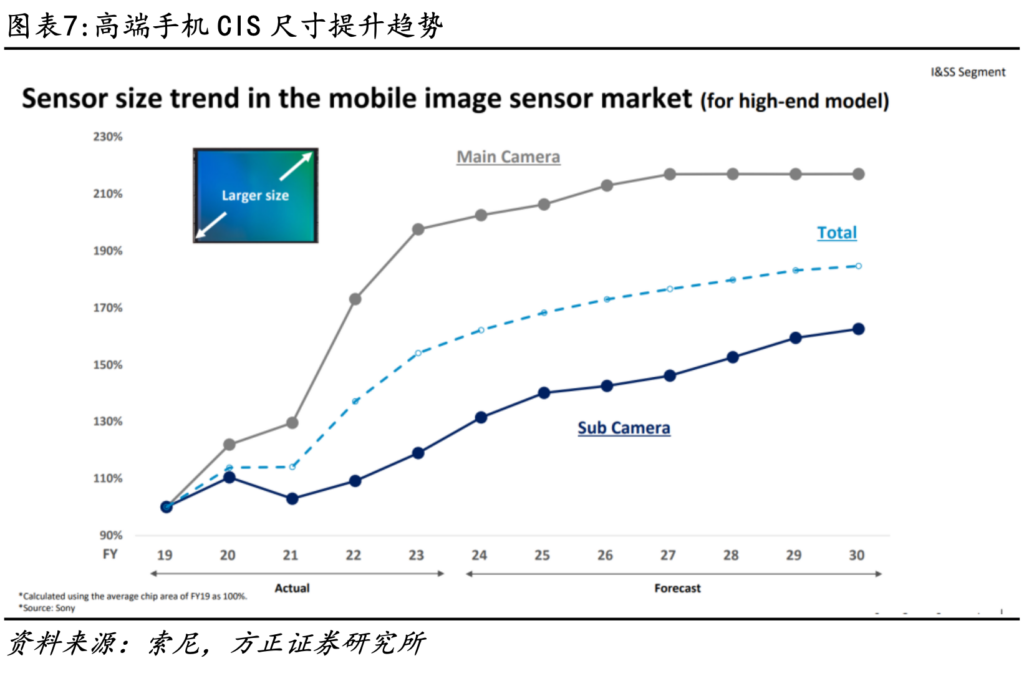
The University of Texas is developing a X-ray vision technology for smartphones. The goal is to develop a chip that allows smartphone users to see through solid surfaces similar to X-rays. But the latter is harmful to humans so instead of actually using X-rays, the phone uses signals in the 200GHz to 400GHz range. Eventually, smartphones with these chips will be able to look inside envelopes and packages. Such devices could also be used by hospitals to check patients’ hydration levels. Right now, the technology requires that the object that the phone seeks to look through be placed no more than an inch away from the device. This prevents a thief from standing far away from his target in order to secretly use the technology to look through a person’s suitcase or bag to discover personal information. (Phone Arena, IEEEXplore, CBS News)
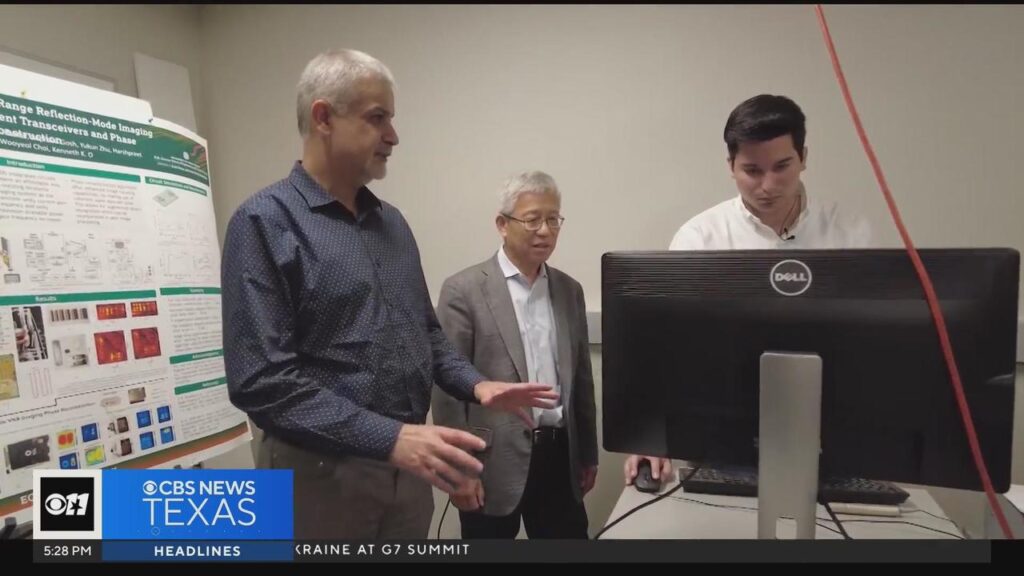

According to IoT Analytics, the number of active IoT devices worldwide will exceed 14B in 2022, a YoY increase of 18%. Sensors are the core of all things’ perception. On average, each newly launched IoT device will be connected to 4 new sensors, which means that more than 50B connected IoT sensors have been deployed. IoT Analytics predicts that the number of connected IoT devices worldwide will exceed 29B in 2027, with a compound annual growth rate of 16% from 2022 to 2027. Sensors will keep pace with the rapid development of the Internet of Things. (Central China Securities report)
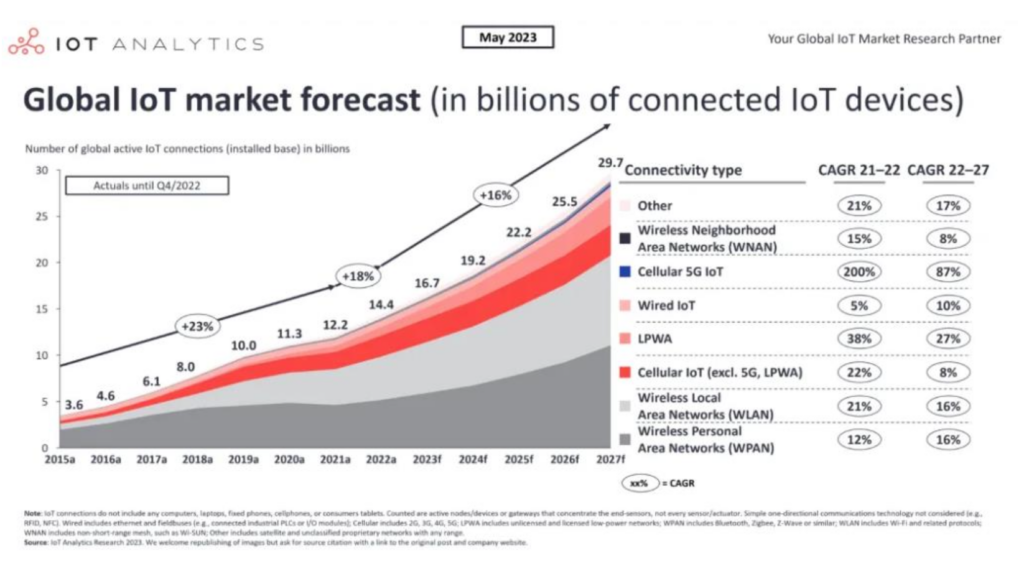
The smart sensor industry chain mainly includes upstream design, raw materials, equipment, midstream sensor manufacturing and packaging testing, and downstream applications. The upstream of smart sensors is product design, as well as the raw materials and equipment needed for production and manufacturing. The raw materials include semiconductor materials, ceramic materials, metal materials, and organic materials; the midstream produces and manufactures various types of sensors, including pressure sensors, acceleration sensors, temperature and humidity sensors, image sensors, photoelectric sensors, etc.; the downstream is applied in consumer electronics, industrial control, automotive electronics, medical electronics and other fields. China’s domestic smart sensor industry chain has basically taken shape, and key enterprises have been deployed in each link. (Central China Securities report)
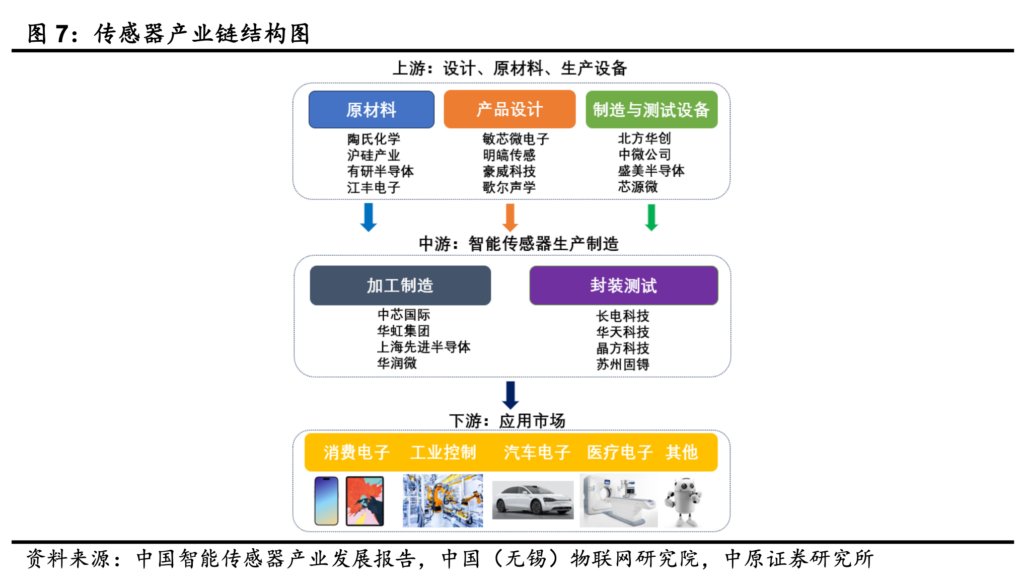
MEMS, or Micro-Electro-Mechanical System, is a micro device or system that uses large-scale integrated circuit manufacturing technology and micro-machining technology to integrate micro sensors, micro actuators, micro structures, signal processing and control circuits, power supplies, and communication interfaces on one or more chips. There are many types of MEMS devices, mainly divided into MEMS sensors and MEMS actuators. (Central China Securities report)
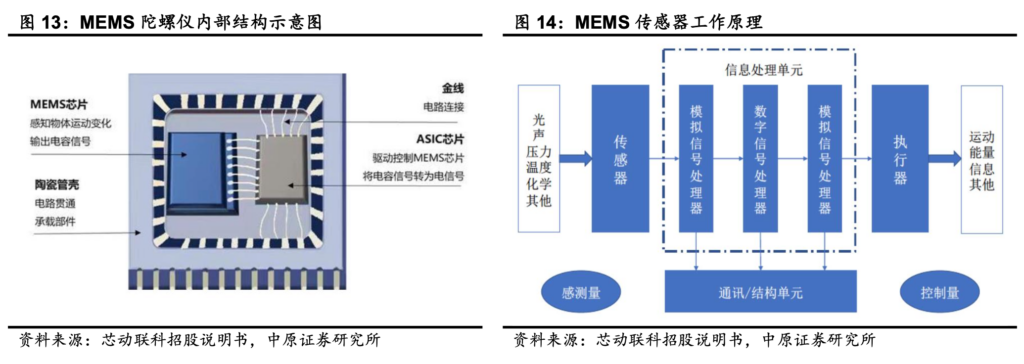
With the advancement of mass production and commercialization of humanoid robots, force sensors have entered a period of rapid growth. According to the forecast of Gaogong Robot Industry Research Institute, by 2030, the global humanoid robot force sensor market size will reach CNY32.8B, of which the six-dimensional force sensor market size in the humanoid robot field will reach CNY13.8B. (Central China Securities report)
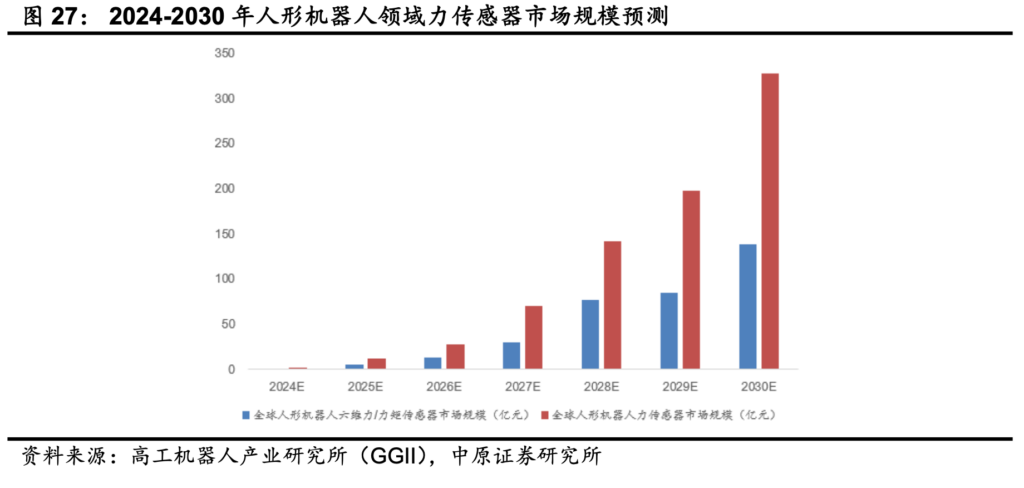
Tesla CEO Elon Musk believes that in the future mobile devices will no longer be needed, and they will be replaced by the Neuralink neural interface. He has indicated that this will allow people to control smartphones and computers without any physical manipulation. In his opinion, the introduction of such technologies will radically change the way people interact with digital devices.(CN Beta, Medium, Twitter)


OnePlus has announced a new smartphone battery technology called the “Glacier Battery,” which was developed in partnership with CATL. The company claims this new battery tech will significantly improve battery life and performance, potentially ushering in a new era of “super endurance” for mobile devices. OnePlus teased details about the Glacier Battery, claiming it will alleviate common user frustrations such as frequent charging, low battery anxiety, and the need for power banks. The company also hinted at a battery capacity that exceeds current standards, offering a “breakthrough” in battery life experience. (Android Authority, GSM Arena, Weibo)


RCC can reduce the thickness of the mainboard (i.e., it can save internal space) and make the drilling process easier because it is fiberglass-free. However, according to TF Securities analyst Ming-chi Kuo, RCC will not be adopted in Apple’s 2024 iPhone 16 due to its fragile characteristics and inability to pass drop tests. Currently, Ajinomoto is the leading supplier of RCC material. If Apple and Ajinomoto can improve the RCC material before 3Q24, the 2025 new high-end iPhone 17 models will use it. According to Mark Gurman of Bloomberg, Apple wants the iPhone 17 to be significantly thinner. The company is also working on making the MacBook Pro and Apple Watch thinner. The plan is to make these devices the thinnest and lightest in their categories across the industry. (Android Authority, Medium, Bloomberg)
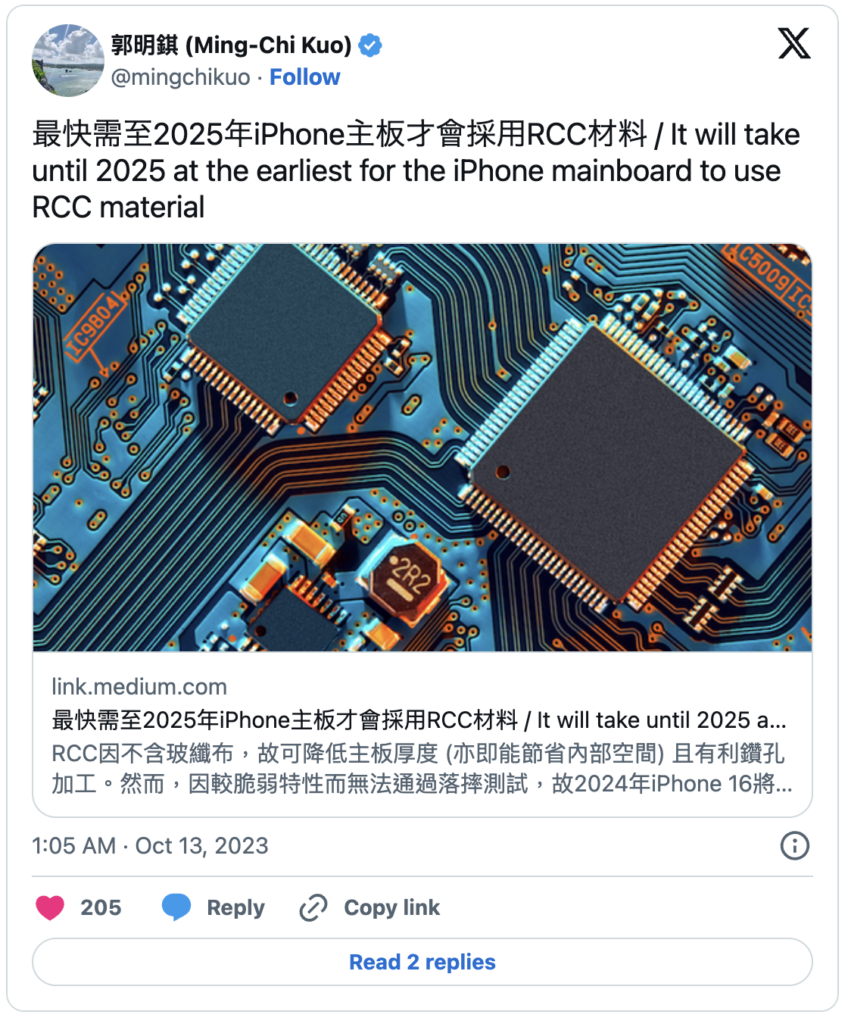

Tata Group is allegedly in talks to acquire a majority stake in the Indian unit of Chinese smartphone maker vivo, which has been seeking local partners following government push to involve domestic companies in its operations, including manufacturing and distribution. vivo and OPPO are allegedly in talks with Indian players for their local units amid growing scrutiny in the country. vivo’s manufacturing factory in Greater Noida has been taken over by Bhagwati Products (Micromax), which has begun hiring staff and will soon start producing smartphones for vivo through its original design manufacturing joint venture with Huaqin. This joint venture between Bhagwati and Huaqin is awaiting approval from the Indian government. (SCMP, Business Today, Money Control, CN Beta)

TrendForce reports that suppliers significantly reduced production targets in the first quarter of last year to address severe inventory accumulation in channels. Consequently, even though 1Q24 smartphone production was below pre-pandemic levels of over 300M units, it still achieved a seemingly impressive 18.7% YoY growth, with a total shipment of 296M units. TrendForce is not optimistic about production numbers for 2Q24, forecasting a decline of 5–10% compared to the previous quarter. In 1Q24, the global top six manufacturers by production market share were Samsung, Apple, Xiaomi, OPPO, Transsion, and vivo. Together, these companies accounted for nearly 80% of the market share. (Android Headlines, TrendForce, TrendForce)
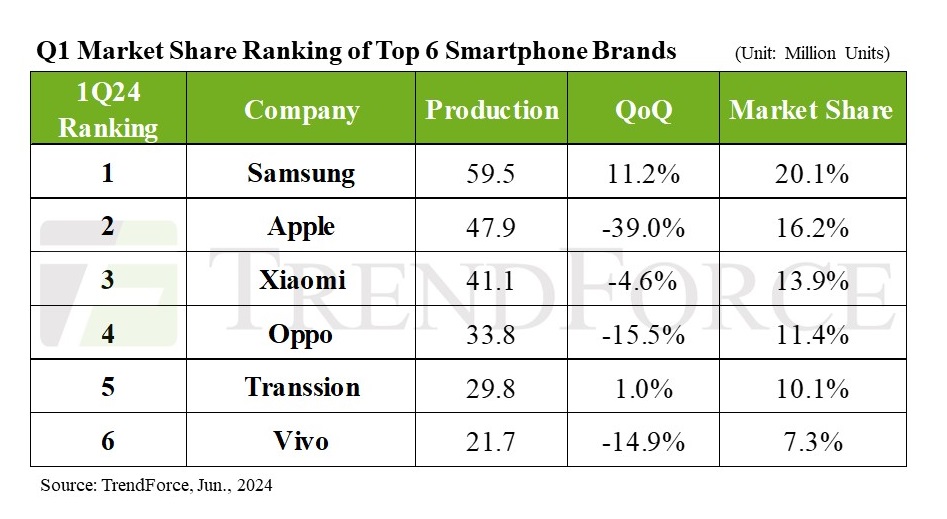
In 1Q24, Samsung Electronics has already produced 64.5M smartphones and tablets, 22% more than the original management plan (52.9M units). The production plan of 49.9M units in 2Q24 is 3% higher than the original management plan (48.3M units). This volume excludes the volume of models produced by joint venture production (JDM), such as China’s Wingtech. Adding the 1Q24 figures and 2Q24 projections, the expected first half production is 114.4M units. This figure is 13% higher than the management plan (101.2M units). However, there are also predictions that Samsung Electronics may reduce production of the same product line in 2H24 to protect profitability. Sales of Samsung Electronics’ new foldable phone, which will be released in Jul 2024, are expected to be a production variable in 2H24. (Phone Arena, The Elec)

Apple Watch Series 10, which is to be launched in 2024, will be thinner and come in larger screen sizes than previous models, according to TF Securities analyst Ming-Chi Kuo. The Series 10 will feature form factor upgrades, including larger screen sizes (increasing from 45mm / 41mm to about 49mm / 45mm) and a thinner design. BLT is the supplier of the 3D-printed components. Unlike 2023, when BLT was an equipment supplier, in 2024, this company will produce the components. Due to the cost advantages of 3D printing, BLT’s shipments of 3D-printed components are expected to continue to grow in the coming years, with the potential to produce Apple Watch cases (as the difficulty is lower compared to the cases of other Apple products). (MacRumors, Medium)

According to data from Precedence Research, the global humanoid robot market size is USD1.62B in 2022 and is expected to reach USD28.66B by 2032, with a compound growth rate of 33.3% from 2022 to 2032. Humanoid robots use force/torque sensors, IMUs, visual sensors, tactile sensors, and acoustic sensors. The humanoid robot industry is about to explode, which is expected to promote the rapid growth of various sensors. (Central China Securities report)
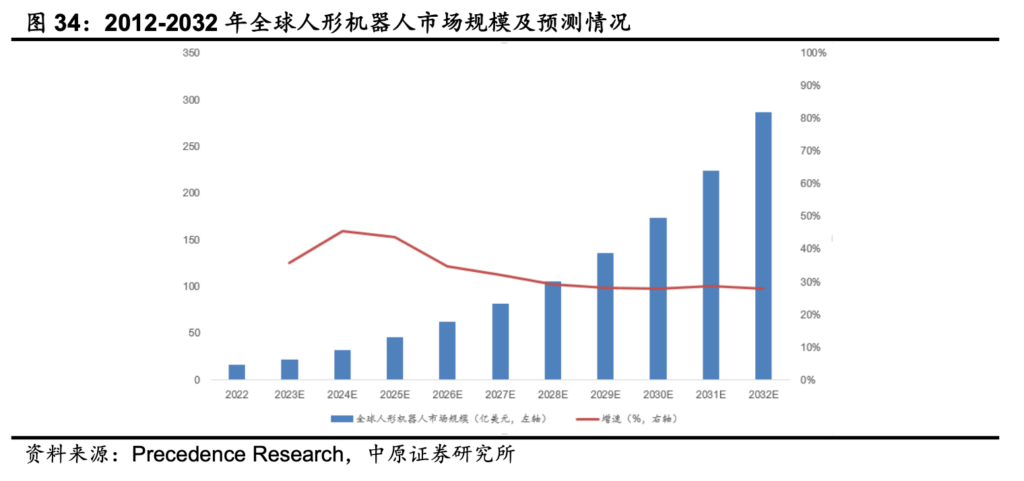
Tesla CEO Elon Musk said that Tesla will eventually offer both rental and sale options for the Optimus robot, with the company set to rent the technology out before starting sales. Tesla is expecting to begin selling Optimus by 2025, which apparently will begin with the company opening rentals. Musk also said that multiple Optimus robots are already performing work at the company’s factory in Fremont, California, mostly sorting battery cells and setting them into shipping containers. He also expects Tesla’s factories to be utilizing more than a thousand Optimus units by 2025. (CN Beta, Twitter, Teslarati)

Tesla CEO Elon Musk has claimed humanoid robots could lift the company’s market cap to USD25T at an unspecified future date. The value of the entire S&P 500 is currently USD45.5T, according to FactSet. Musk promised Tesla would move into “limited production” of Optimus in 2025 and test out humanoid robots in its own factories in 2025. The company, he predicted, will have “over thousand, or a few thousand, Optimus robots working at Tesla” in 2025. (CNBC)
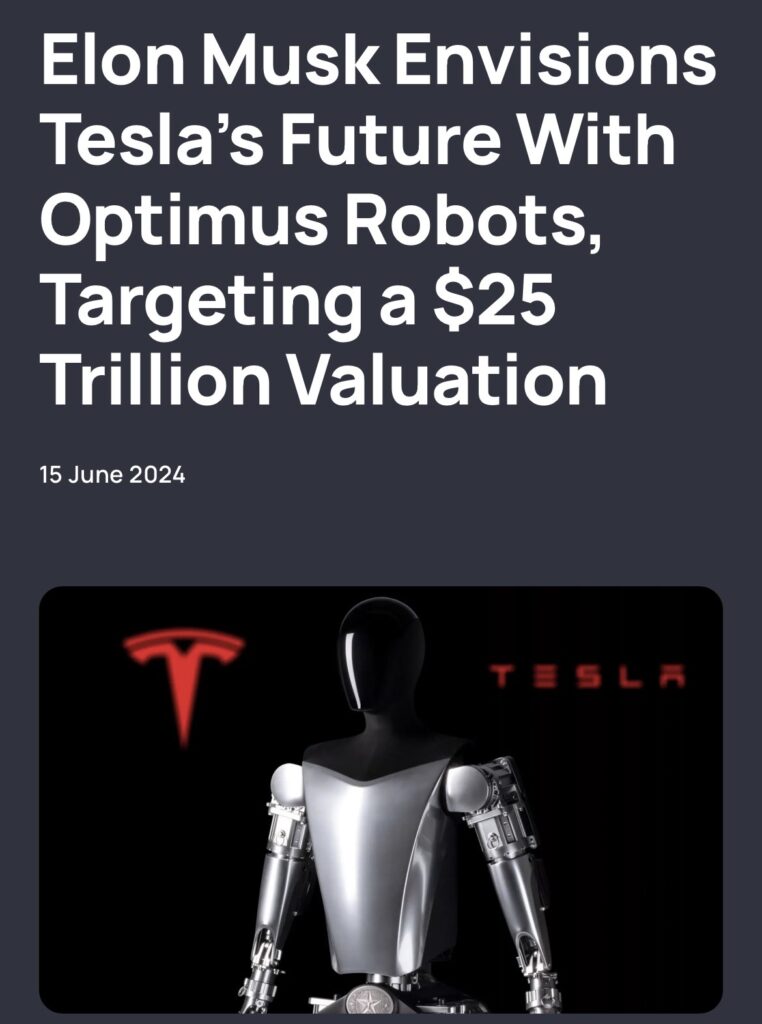

Apple has announced that it is no longer offering Apple Pay Later, the “buy now, pay later” service that launched in the United States in 2023. Existing users with open Apple Pay Later loans will still be able to manage them via the Wallet app. Apple is focusing on new features coming globally to Apple Pay later 2024, including the ability to access instalment loan offerings from eligible credit or debit cards, as well as Affirm. Users who have an active loan through Apple Pay Later will still be able to manage and pay their loans using the Apple Wallet app. (The Verge, 9to5Mac, Apple)
